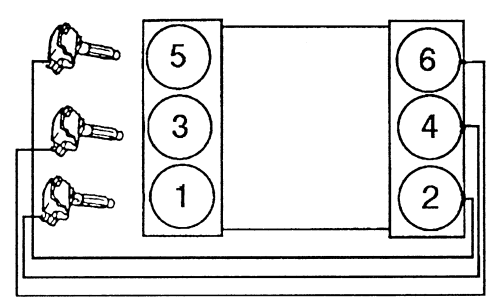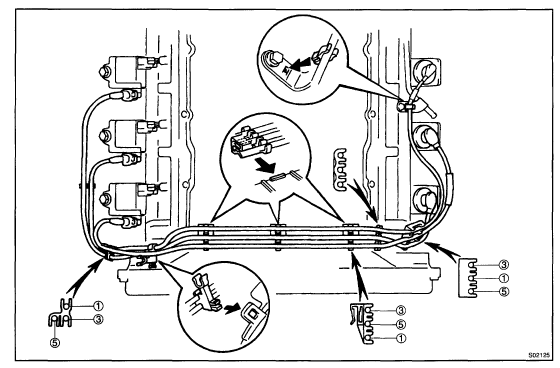If you’re looking for a step-by-step guide to checking the firing order on a Toyota 3.4 engine, you’ve come to the right place. We’ll walk you through the process of understanding the firing order and checking it on your vehicle, so you can have the peace of mind that your Toyota 3.4 engine is in proper working order. Let’s get started!
Firing Order Toyota 3.4
- The firing order for the Toyota 3.4L engine is 1-2-3-4-5-6
The Explanation for Toyota Firing Order
The firing order for the Toyota 3.4 Liter engine is 1-2-3-4-5-6. The 8-cylinder Powerstroke engine has a cast iron block. Each cylinder has six head bolts, and the pistons are cast aluminum. The engine had an overhead valve (OHV) with two valves per cylinder and hydraulic lifters. Over time, the horsep[ower changed. The Powerstroke was given 210 HP when it was first introduced in 1994, but the HP was revised starting in 1996. The engine produced 215 HP in that year, compared to 225 HP in 1997–1998.
A further boost to 235 HP was seen in 1999–2000, then from 2001–2003, the automatic gearbox received 250 HP while the manual gearbox received 275 HP. The business eventually split the torque, with the manual gearbox having 525 lb-ft and the 2001 to 2003 auto gearbox having 501 lb-ft. Throughout the Power Stroke engine’s operation, the compression remained constant at 17.5:1.
The firing order applies to
- Toyota Tacoma
- Toyota 4Runner
- Toyota Tundra
Torque specification
| Fastener type | Torque specs |
|---|---|
| Main Cap Bolt (396-427, 2-Bolt) | 85 ft.-lbs. |
| Main Cap Bolt (396-454, 4-Bolt, Inner and Outer) | 100 ft.-lbs. |
| 3/8 in. Connecting Rod Bolt | 55 ft.-lbs. |
| 7/16 in. Connecting Rod Bolt | 67-79 ft.-lbs. |
| Cylinder Head Bolts, Long | 85 ft.-lbs. |
| Cylinder Head Bolts, Short | 55-68 ft.-lbs. |
| Screw-In Rocker Arm Studs | 60 ft.-lbs. |
| Intake Manifold Bolts (Cast Iron Head) | 35 ft.-lbs. |
| Main Cap Bolt (396-427, 2-Bolt) | 95 ft.-lbs. |
How to Check the Firing Order of Your Car?

Checking the firing order of a Toyota 3.4 engine is a simple task that can be done with just a few steps. The firing order for this engine is 1-2-3-4-5-6, with the number one cylinder being the one closest to the front of the engine. For confirmation of the gun’s firing order, perform the following operations:
Step 1: Disconnect the Battery:
Before starting any work on your engine, it is important to disconnect the battery to prevent any accidents or damage. Just look for the power supply beneath the windscreen and use a tool like a wrench to unplug the other end of the cable.
Step 2: Replace the Connector Knob:
The spark plug wires attach to the converter at the cap that covers the distributor. It is typically found behind the engine on top of the engine. Find the manual for your vehicle if you have trouble doing it.
Step 3: Examine the cylinder:
Check the wires on the end of the distributor cap in the following order, starting with the first cylinder.
They should be connected in the correct order, which is 1-2-3-4-5-6 for the Toyota 3.4 engine. Just relocate them to the proper spots wherever they are not in the right order.
Step 4: Check for Spark:
Once you have checked and corrected the wire order, it’s time to check for spark. Reconnect the battery, start the engine, and use a spark tester to check each spark plug wire for spark. If you don’t have a spark tester, you can use a screwdriver. Simply place the metal end of the screwdriver against the wire, and hold the handle of the screwdriver close to a metal part of the engine. When you touch the screwdriver to the engine metal part, you should see a spark jump.
Step 5: Double Check the Firing Order:
If you have spark on all cylinders, double-check the wire order on the distributor cap to make sure it is correct. If it is not correct, you will have problems with your engine.
Following these steps will ensure that your Toyota 3.4 engine is firing in the correct order, which will result in better performance and fuel efficiency. Whether you have 2001, a 2002, or a 2003 firing order, these steps will work for any year and model.
Check out Inline 6 Firing Order
Firing orders for similar vehicles
- Lexus GX 470
- Lexus LX 470
What are the signs of Incorrect Firing Order?
If your Toyota 3.4 engine has an incorrect firing order, you may experience a range of symptoms that can lead to significant performance issues. The firing order of an engine dictates the sequence in which each cylinder receives a spark, and if it is off, it can lead to several issues. Here are some of the symptoms you may notice if your Toyota 3.4 engine has an incorrect firing order:
Rough Idle:
Your engine may vibrate and produce a rough sound when it is idle if the firing order is incorrect. This symptom can worsen as the engine revs higher.
Misfires:
Misfires can occur when a cylinder fails to receive the right amount of fuel and spark. Especially when climbing hills or accelerating, you may notice your engine running sluggishly
Reduced Power:
If your engine isn’t receiving the proper spark, it will lose power. This symptom is noticeable when accelerating and when carrying a load, such as towing a trailer.
Engine Stalling:
When the firing order is off, your engine may stall or shut off randomly. This issue can be dangerous if it occurs while driving, so it is important to diagnose and fix the problem immediately.
Poor Fuel Economy:
Your vehicle may have poor fuel economy if the firing order is off. This symptom can occur because the engine isn’t running efficiently, resulting in excess fuel consumption.
In summary, if you notice any of the symptoms above on your 2002 Toyota Tacoma 3.4 cylinder order or 2001 Toyota 3.4 firing order, it’s essential to get it checked out by a qualified mechanic as soon as possible. It’s a problem that shouldn’t be ignored, as it can cause serious damage to your engine and decrease your vehicle’s overall performance.
Conclusion:
Checking the firing order of your Toyota 3.4 engine is an essential maintenance step that you should not overlook. Failure to maintain the correct firing order can lead to several engine problems that can be costly to fix. However, with this step-by-step guide, you can easily check your engine’s firing order, ensuring that it runs smoothly and efficiently.
Whenever you make any adjustments or repairs to your vehicle’s engine, make sure to follow the manufacturer’s instructions. Keeping your vehicle well-maintained will not only save you money in the long run but will also ensure that your car lasts for years to come.
1995–2004 Toyota Tacoma 3.4L V6 Firing Order and Cylinders Location Video
- 2007 Toyota Camry Firing Order (With Diagram) - February 2, 2024
- 2008 Honda Accord Firing Order (With Diagram) - February 2, 2024
- 2001 Honda Accord Firing Order (With Diagram) - February 2, 2024



![6.0 Powerstroke Firing Order [With Diagram] 6.0 Powerstroke firing order 1](https://nerdycar.com/wp-content/uploads/2023/05/All-You-Need-To-Know-About-the-6.0-Powerstroke-Cylinders-1024x683-1-150x150.jpg)
![7.3 Powerstroke Firing Order [With Diagram] 7.3 Powerstroke Firing Order 1](https://nerdycar.com/wp-content/uploads/2023/05/Ford-7-1-150x150.webp)
![Ford 302 Firing Order [With Diagram] Ford 302 Firing Order](https://nerdycar.com/wp-content/uploads/2022/06/maxresdefault-3-1.jpg)
![Small Block Chevy Firing Order [With Diagram] Small Block Chevy Firing Order](https://nerdycar.com/wp-content/uploads/2022/06/main-qimg-5aa485bc1e13d73ad64783d096244b57-pjlq-1.jpg)
![Ford 5.8 Firing Order [With Diagram] Ford 5.8 firing order 1](https://nerdycar.com/wp-content/uploads/2023/05/What-Is-A-351-Windsor-Firing-Order-0--150x150.webp)
![Ford F150 Firing Order for 4.2 [With Diagram] Ford F150 Firing Order 4.2 1](https://nerdycar.com/wp-content/uploads/2023/05/pic-6529684858141239648-1600x1200-1-150x150.png)